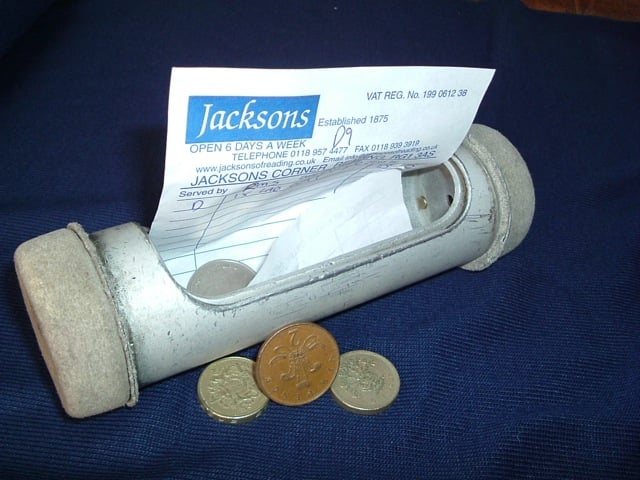Cash carrying systems in department stores
Many people may remember visiting shops that were fitted with a ‘cash carrier’ used for sending customer cash payments to the cash office.
There were two types of cash-carrying systems that whizzed money and invoices around old-fashioned department stores.
One was a mechanical system, in which gravity helped propel the cash-containing pods along wires; the other was a pneumatic system in which a blast of compressed air or suck from a vacuum had the pods in motion.
The most well-known system in the UK was the rapid wire system, where the cash carrier ran on a wire on the ceiling. Sadly, when many shops became self-service the systems were removed and scrapped.
The Cash Railway
The mechanical system or cash railway was first patented in 1881 by William Stickney Lamson of Massachusetts in the US.
Lamson halved a hollow wooden ball, placed the cash inside it, screwed the halves together and then placed the ball on wires strung on a slight incline across the shop. The ball then rolled along the wires to the cash office.
Wooden tracks were later added, and balls of different weight and diameter were dropped down different chutes into various departments.
By 1885, Mr Lamson’s system was being introduced into the UK.
A working example can be seen in the Co-op at the Beamish Museum, County Durham. Co-ops were especially keen on the systems because they meant that as well as keeping the money safe from would-be thieves at the front of the store, the accountants were able to carry out complex calculations about the dividends quickly and accurately.
The Pneumatic System
The other form of cash-carrying system was pneumatic, and this was invented in Cornwall by steam locomotive engineer William Murdoch in the 1780s.
Murdoch was experimenting with the power of air being blasted through a tube and in 1836 added a capsule to his air tubes. This is when his idea really began to take off and many stores began to install his pneumatic system.
In 1894, the Bishop Auckland Co-operative Flour and Provision Society finished building its splendid run of buildings in Newgate Street, and it opened them on July 14 with “one of the greatest events this town has ever witnessed”.
The Northern Echo reported: “The great feature in connection with Messrs Kilburn & Sykes’s contract is the fixing of pneumatic cash tubes, which convey the cash in leather carriers from every department in the premises (both old and new buildings) to the central cash office.”
Jacksons of Reading
Jacksons of Reading Department Store demonstrating how the Lamson pneumatic system worked for them. Installed at the store in the 1940s, the Lamson cash transfer machine remained in use until the store closed in 2013.
Not just retail
It wasn’t just in retail where these systems were used. Industry made great use of them too.
“I worked at Wheatly Motors, Yarm Lane, Stockton, in the early 1970s where there was a vacuum system running between the workshop and the stores and reception,” remembers DJ Nicholson from Fishburn. “As a jolly jape, the mechanics used to put mice in the tube to scare the girls in the reception!”
Do you remember a cash-carrier in your local store? Did you ever use one?
Melina - Assistant Editor
Latest posts by Melina - Assistant Editor (see all)
- Top tips for hay fever sufferers - April 14, 2024
- Paysan Breton Cream Cheese Breakfast Wraps - April 12, 2024
- 4 Homemade Sweet Treats for Easter - March 24, 2024
- Playground Memories - March 10, 2024
- The invasion of the duvet: the ’10-second bed’ - February 20, 2024





















